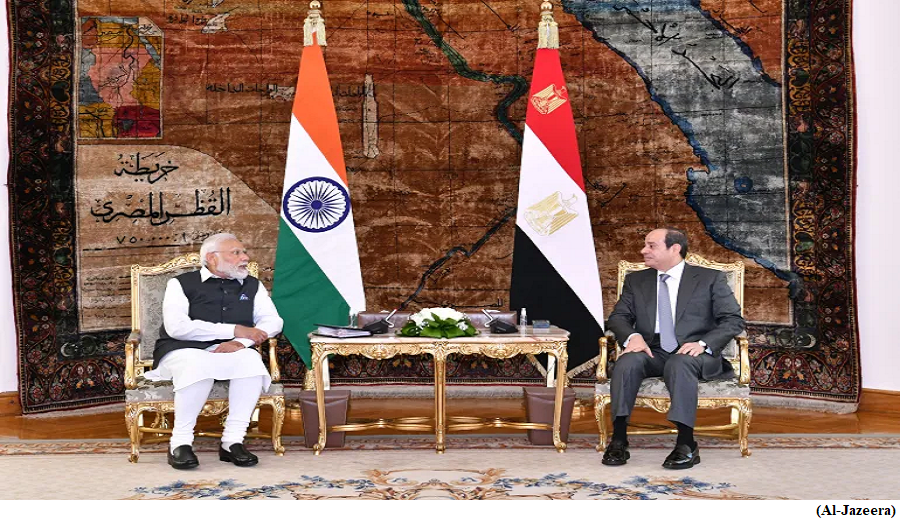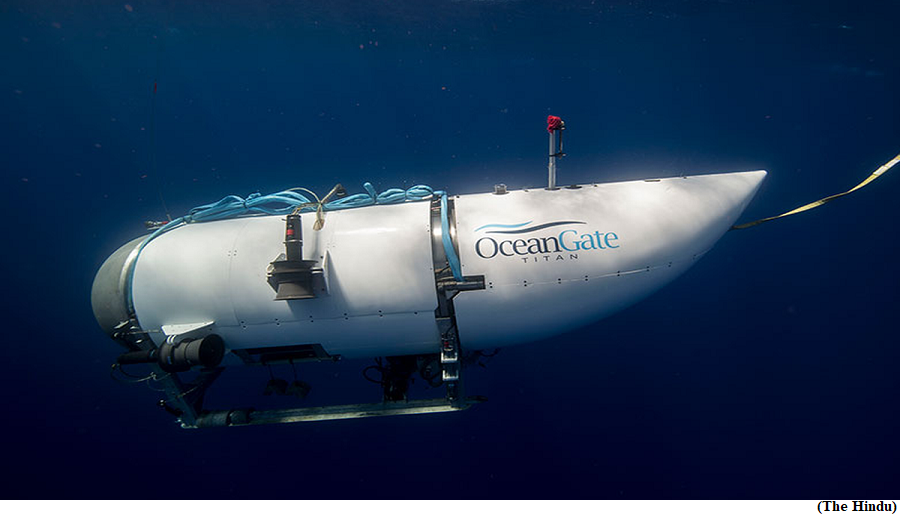The India U.S. deal for 31 MQ 9B drones (GS Paper 3, Defence)

Why in news?
- U.S President and Prime Minister jointly welcomed India’s plans to procure General Atomics MQ-9B High Altitude Long Endurance (HALE) Unmanned Aerial vehicles (UAV).
- This sets the stage for the acquisition of 31 of these armed UAVs, 15 SeaGuardians for the Indian Navy and 16 SkyGuardians, eight each for the Indian Army and Air Force.
What is the cost and the process to be followed?
- The MQ-9Bs, which will be assembled in India, will enhance the Intelligence, Surveillance, and Reconnaissance (ISR) capabilities of India’s armed forces across domains.
- As part of this plan, General Atomics will also establish a Comprehensive Global Maintenance, Repair and Overhaul (MRO) facility in India in support of India’s long-term goals to boost indigenous defence capabilities.
- The deal will be executed through the Foreign Military Sales (FMS) route of the U.S. government and is expected to take a few months to be concluded.
- Under the FMS route, a Letter of Request (LOR) would be sent to the U.S. government where tri-services requirements, details of equipment and terms of the procurement would be included.
- Based on the LOR, the U.S. government and the MoD will finalise the Letter of Offer and Acceptance (LOA) where details of equipment and terms of the procurement would be negotiated and finalised in accordance with the FMS programmeand the price and terms offered by the U.S. Government and General Atomics to other countries.
- In the final step, the deal has to be approved by the Cabinet Committee on Security after which the contract will be concluded.
What do the UAV’s bring in terms of capability?
- The MQ-9B has two variants; the SkyGuardian and the SeaGuardian, its maritime variant.
- The MQ-9B is designed to fly over the horizon via satellite for up to 40 hours, depending on configuration, in all types of weather and safely integrate into civil airspace, according to its manufacturer.
- For instance, the SeaGuardian configuration can include a 360-degree surface-search maritime radar, automatic identification system, sonobuoy monitoring system, and sonobuoy dispensers for persistent anti-surface and anti-submarine warfare missions.
- The MQ-9B can provide roughly 80% of the capability of a large human-flown maritime patrol aircraft at about 20% of its cost per hour.
- For the Army and Air Force, the MQ-9Bs can provide round-the-clock surveillance looking far beyond the borders, for instance on the movement of Chinese military buildup and troop movement along the Line of Actual Control (LAC) and deep inside.
- It also seamlessly integrates with other U.S.-origin platforms that India operates, the P-8Is, AH-64 Apache attack helicopters, MH-60R multi-role helicopters among others expanding MQ-9B’s multi-domain mission set.
What UAVs are already in service?
- The Indian Navy has leased two MQ-9As from General Atomics with the maiden flight taking place on November 21, 2020. In their two years of operation till November 2022, they had completed 10,000 flight hours, and “helped the Indian Navy to cover over 14 million square miles of operating area”.
- At Aero India in Bengaluru in February 2023, Hindustan Aeronautics Limited (HAL) and General Atomics announced that the turbo-propeller engines which power the MQ-9B will be supported by HAL’s engine division for the Indian market.
- The MQ-9 is a significant technological leap from the original RQ-1/MQ-1Predator that heralded the arrival of long endurance armed drones at the end of the twentieth century.
- Armed with AGM-114 Hellfire missiles, the Predator became a symbol of the U.S. war on terror after the 9/11 attacks, with their extensive employment in Afghanistan and the tribal areas of Pakistan in the early 2000s.
- The RQ-1 Predator, which was first flown by the U.S. Air Force (USAF) in 1995, was retired in 2018 and replaced by the MQ-9 Reaper.
PM Modi Egypt visit, expanding ties in trade, renewables, IT discussed
(GS Paper 2, International Relation)
Why in news?
- On his way back from the United States, recently Indian Prime Minister visited Egypt.

Key Highlights:
- Greater cooperation in trade and investment, renewable energy, and information technology was discussed during Indian Prime Minister’s meeting with Egyptian Prime Minister.
- Green hydrogen, digital payment platforms, pharma, and people-to-people ties also figured in the talks.
Bilateral relations:
- During the visit, Indian Prime Minister Modi had a comprehensive bilateral meeting with Egyptian President Abdel Fattah El-Sisi, who also conferred him with the highest state honour of Egypt, the 'Order of Nile.'
- The Egyptian President had been the chief guest at the 2023 Republic Day celebrations in Delhi as part of his second state visit to India.
- The Egyptian President has constituted the India unit. It is focused on quickly expanding business and political engagement with India.
- Egypt has also been invited as a special guest during the Group of Twenty meetings in India.
Expanding trade:
- India's bilateral trade with Egypt stood at $6.06 billion in 2022-23, down from the record high of $7.26 billion in the previous year.
- India has maintained a trade surplus with Egypt with exports of $4.1 being more than double that of imports ($1.95 billion) in FY23.
- Exports from India to Egypt are broad-based, but diesel and followed by organic chemicals ($311 million), heavy machinery ($256 million), iron & steel ( $223 million), and cotton ($201 million). Refined petroleum is the single biggest import item from the country.
- The India-Egypt Bilateral Trade Agreement has been in operation since March 1978 but trade has been slow to take off. India was Egypt's fifth-largest trading partner in 2022.
- Around 50 Indian companies have invested upwards of $3.2 billion in apparel, agriculture, chemicals, energy, automobiles, and retail. Directly and indirectly, they employ approximately 35,000 Egyptians.
- Major Indian investments in Egypt include TCI Sanmar, Alexandria Carbon Black, Kirloskar, Dabur India, FLEX P. FILMS, SCIB Paints, Godrej, Mahindra, and Monginis. Indian companies are present in a range of sectors like
The Titan tragedy, how did the Titanic tourist submersible operate?
(GS Paper 3, Science and Technology)
Why in news?
- Recently, all five passengers on a submersible named Titan died in a ‘catastrophic implosion’.
- They were travelling to see the wreckage of the RMS Titanic, which is nearly four thousand metres under water in the frigid North Atlantic Ocean.

What is the Titan submersible?
- Titan is a submersible, or an underwater vehicle. It is operated by the privately owned U.S. company OceanGate that organises underwater expeditions for both research and tourism.
- The company claims that Titan, which it said was built with “off-the-shelf” components, is lighter and more cost-efficient than other deep diving submersibles.
- The 6.7-metre-long manned submersible is intended for “site survey and inspection, research and data collection, film and media production, and deep sea testing of hardware and software.
- Its expeditions were meant to document the Titanic and its rate of decay on the ocean floor, and that all expeditions were in line with the National Oceanic and Atmospheric Administration (NOAA) Guidelines for Research, Exploration and Salvage of RMS Titanic, as well as the UNESCO guidelines for the preservation of underwater world heritage sites.
What do these guidelines say?
- The wreckage of the Titanic is a grave site where victims experienced unimaginable horror and suffering in their final hours. For this reason, international guidelines are in place to protect the now rust-covered wreckage which is scattered across the ocean bed, as well as the visitors who wish to see it.
- The UNESCO guidelines stress on the long-term preservation of “underwater cultural heritage” and the need to protect the surrounding waters by ensuring “responsible non-intrusive access.”
- The NOAA guidelines are similar and insist that recovered material and artefacts must be managed as per professional standards. In other words, taking souvenirs from the wreckage site is strongly discouraged.
What is the difference between a submarine and a submersible?
- While the two categories can overlap, a submarine refers to an underwater vehicle that is largely independent and has power reserves to help it depart from a port or come back to the port after an expedition.
- Meanwhile, a submersible is generally smaller in size and has less power, so it needs to work with a ship in order to be launched and recovered.
How was the submersible operated?
- Titan is made of carbon fibre and titanium, and weighs 10,432 kilograms. It is capable of going 4,000 metres undersea, and moves as fast as three knots per hour (5.56 kph).
- There is space for five crew members to sit on the floor, though not stand. While there is a small porthole window at one end, below 1,000 metres no sunlight reaches the ocean so the submersible would have to rely on its own lighting.
- The submersible is dependent on external crew members, as it is bolted from the outside. Titan also has an integrated launch and recovery platform.
- Titan had only one button inside and that the submersible was run with a “Sony PlayStation-style controller” made by Logitech. The gaming-style controller devices are also used by some drone operators, navy personnel, and robot operators. Game controllers are cheap, easy to buy in bulk, designed to be intuitive, and respond quickly to the users’ hand movements.
Issues raised by whistle-blower:
- In 2018, OceanGate fired its employee David Lochridge and sued him after he filed a whistle-blower complaint with the Occupational Safety and Health Administration over the safety of the Titan submersible. He allegedly pushed for better testing of the submersible’s hull before sending it down for dives.
- According to his court filings, he learned that “the viewport at the forward of the submersible was only built to a certified pressure that is felt at 1,300 metres, although OceanGate intended to take passengers down to depths of 4,000 metres”.
- His other concerns included the “experimental” design, a lack of comprehensive hull testing, and the use of hazardous flammable materials inside the submersible, as per the filings.
Way Forward:
- The submersible has ignited worldwide debate about the ethics of dark tourism and the need to regulate technological innovation in high-risk sectors.




